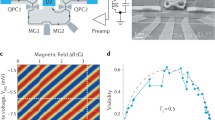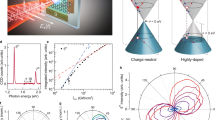Abstract
Electron interferometry with quantum Hall (QH) edge channels in semiconductor heterostructures can probe and harness the exchange statistics of anyonic excitations. However, the charging effects present in semiconductors often obscure the Aharonov–Bohm interference in QH interferometers and make advanced charge-screening strategies necessary. Here we show that high-mobility monolayer graphene constitutes an alternative material system, not affected by charging effects, for performing Fabry–Pérot QH interferometry in the integer QH regime. In devices equipped with gate-tunable quantum point contacts acting on the edge channels of the zeroth Landau level, we observe—in agreement with theory—high-visibility Aharonov–Bohm interference widely tunable through electrostatic gating or magnetic fields. A coherence length of 10 μm at a temperature of 0.02 K allows us to further achieve coherently coupled double Fabry–Pérot interferometry. In future, QH interferometry with graphene devices may enable investigations of anyonic excitations in fractional QH states.
This is a preview of subscription content, access via your institution
Access options
Access Nature and 54 other Nature Portfolio journals
Get Nature+, our best-value online-access subscription
$29.99 / 30 days
cancel any time
Subscribe to this journal
Receive 12 print issues and online access
$259.00 per year
only $21.58 per issue
Buy this article
- Purchase on Springer Link
- Instant access to full article PDF
Prices may be subject to local taxes which are calculated during checkout




Similar content being viewed by others
Data availability
The data that support the findings of this study are available from the corresponding author upon reasonable request.
References
van Wees, B. J. et al. Observation of zero-dimensional states in a one-dimensional electron interferometer. Phys. Rev. Lett. 62, 2523–2526 (1989).
Ji, Y. et al. An electronic Mach–Zehnder interferometer. Nature 422, 415–418 (2003).
Bäuerle, C. et al. Coherent control of single electrons: a review of current progress. Rep. Prog. Phys. 81, 056503 (2018).
Chamon, C., Freed, D. E., Kivelson, S. A., Sondhi, S. L. & Wen, X. G. Two point-contact interferometer for quantum Hall systems. Phys. Rev. B 55, 2331–2343 (1997).
Fradkin, E., Nayak, C., Tsvelik, A. & Wilczek, F. A Chern–Simons effective field theory for the Pfaffian quantum Hall state. Nucl. Phys. B 516, 704–718 (1998).
Das Sarma, S., Freedman, M. & Nayak, C. Topologically protected qubits from a possible non-Abelian fractional quantum Hall state. Phys. Rev. Lett. 94, 166802 (2005).
Bonderson, P., Kitaev, A. & Shtengel, K. Detecting non-Abelian statistics in the ν = 5/2 fractional quantum Hall state. Phys. Rev. Lett. 96, 016803 (2006).
Chung, S. B. & Stone, M. Proposal for reading out anyon qubits in non-Abelian ν = 12/5 quantum Hall state. Phys. Rev. B 73, 245311 (2006).
Stern, A. & Halperin, B. I. Proposed experiments to probe the non-Abelian ν = 5/2 quantum Hall state. Phys. Rev. Lett. 96, 016802 (2006).
Feldman, D. E. & Kitaev, A. Detecting non-Abelian statistics with an electronic Mach–Zehnder interferometer. Phys. Rev. Lett. 97, 186803 (2006).
Stern, A., Rosenow, B., Ilan, R. & Halperin, B. I. Interference, Coulomb blockade, and the identification of non-Abelian quantum Hall states. Phys. Rev. B 82, 085321 (2010).
Camino, F. E., Zhou, W. & Goldman, V. J. e/3 Laughlin quasiparticle primary-filling ν = 1/3 interferometer. Phys. Rev. Lett. 98, 076805 (2007).
Zhang, Y. et al. Distinct signatures for Coulomb blockade and Aharonov–Bohm interference in electronic Fabry–Perot interferometers. Phys. Rev. B 79, 241304 (2009).
McClure, D. T. et al. Edge-state velocity and coherence in a quantum Hall Fabry–Pérot interferometer. Phys. Rev. Lett. 103, 206806 (2009).
Ofek, N. et al. Role of interactions in an electronic Fabry–Perot interferometer operating in the quantum Hall effect regime. Proc. Natl Acad. Sci. USA 107, 5276–5281 (2010).
McClure, D. T., Chang, W., Marcus, C. M., Pfeiffer, L. N. & West, K. W. Fabry–Perot interferometry with fractional charges. Phys. Rev. Lett. 108, 256804 (2012).
Willett, R. L., Nayak, C., Shtengel, K., Pfeiffer, L. N. & West, K. W. Magnetic-field-tuned Aharonov–Bohm oscillations and evidence for non-Abelian anyons at ν = 5/2. Phys. Rev. Lett. 111, 186401 (2013).
Choi, H. K. et al. Robust electron pairing in the integer quantum Hall effect regime. Nat. Commun. 6, 7435 (2015).
Sivan, I. et al. Observation of interaction-induced modulations of a quantum Hall liquid’s area. Nat. Commun. 7, 12184 (2016).
Rosenow, B. & Halperin, B. I. Influence of interactions on flux and back-gate period of quantum Hall interferometers. Phys. Rev. Lett. 98, 106801 (2007).
Halperin, B. I., Stern, A., Neder, I. & Rosenow, B. Theory of the Fabry–Pérot quantum Hall interferometer. Phys. Rev. B 83, 155440 (2011).
Ngo Dinh, S. & Bagrets, D. A. Influence of Coulomb interaction on the Aharonov–Bohm effect in an electronic Fabry–Pérot interferometer. Phys. Rev. B 85, 073403 (2012).
Röösli, M. P. et al. Observation of quantum Hall interferometer phase jumps due to a change in the number of bulk quasiparticles. Phys. Rev. B 101, 125302 (2020).
Nakamura, J. et al. Aharonov–Bohm interference of fractional quantum Hall edge modes. Nat. Phys. 15, 563–569 (2019).
Nakamura, J., Liang, S., Gardner, G. C. & Manfra, M. J. Direct observation of anyonic braiding statistics. Nat. Phys. 16, 931–936 (2020).
Bartolomei, H. et al. Fractional statistics in anyon collisions. Science 368, 173–177 (2020).
Wang, L. et al. One-dimensional electrical contact to a two-dimensional material. Science 342, 614–617 (2013).
Du, X., Skachko, I., Duerr, F., Luican, A. & Andrei, A. Y. Fractional quantum Hall effect and insulating phase of Dirac electrons in graphene. Nature 462, 192–195 (2009).
Bolotin, K. I., Ghahari, F., Shulman, M. D., Stormer, H. L. & Kim, P. Observation of the fractional quantum Hall effect in graphene. Nature 462, 196–199 (2009).
Dean, C. R. et al. Multicomponent fractional quantum Hall effect in graphene. Nat. Phys. 7, 693–696 (2011).
Kim, Y. et al. Even denominator fractional quantum Hall states in higher Landau levels of graphene. Nat. Phys. 15, 154–158 (2019).
Zibrov, A. A. et al. Even-denominator fractional quantum Hall states at an isospin transition in monolayer graphene. Nat. Phys. 14, 930–935 (2018).
Young, A. F. et al. Tunable symmetry breaking and helical edge transport in a graphene quantum spin Hall state. Nature 505, 528–532 (2014).
Veyrat, L. et al. Helical quantum Hall phase in graphene on SrTiO3. Science 367, 781–786 (2020).
Yankowitz, M., Ma, Q., Jarillo-Herrero, P. & LeRoy, B. J. Van der Waals heterostructures combining graphene and hexagonal boron nitride. Nat. Rev. Phys. 1, 112–125 (2019).
Nakaharai, S., Williams, J. R. & Marcus, C. M. Gate-defined graphene quantum point contact in the quantum Hall regime. Phys. Rev. Lett. 107, 036602 (2011).
Veyrat, L. et al. Low-magnetic-field regime of a gate-defined constriction in high-mobility graphene. Nano Letters 19, 635–642 (2019).
Wei, D. S. et al. Mach–Zehnder interferometry using spin- and valley-polarized quantum Hall edge states in graphene. Sci. Adv. 3, e1700600 (2017).
Makk, P. et al. Coexistence of classical snake states and Aharonov–Bohm oscillations along graphene p–n junctions. Phys. Rev. B 98, 035413 (2018).
Zhang, G. et al. Coulomb-dominated oscillations in a graphene quantum Hall Fabry–Pérot interferometer. Chin. Phys. B 28, 127203 (2019).
Zimmermann, K. et al. Tunable transmission of quantum Hall edge channels with full degeneracy lifting in split-gated graphene devices. Nat. Commun. 8, 14983 (2017).
Yamauchi, Y. et al. Universality of bias- and temperature-induced dephasing in ballistic electronic interferometers. Phys. Rev. B 79, 161306 (2009).
Gurman, I., Sabo, R., Heiblum, M., Umansky, V. & Mahalu, D. Dephasing of an electronic two-path interferometer. Phys. Rev. B 93, 121412 (2016).
Ronen, Y. et al. Aharonov–Bohm effect in graphene-based Fabry–Pérot quantum Hall interferometers. Nat. Nanotechnol. https://doi.org/10.1038/s41565-021-00861-z (2021).
Amet, F. et al. Supercurrent in the quantum Hall regime. Science 352, 966–969 (2016).
Lee, G. et al. Inducing superconducting correlation in quantum Hall edge states. Nat. Phys. 13, 693–698 (2017).
Zhao, L. et al. Interference of chiral Andreev edge states. Nat. Phys. 16, 862–867 (2020).
Huang, X. L. & Nazarov, Y. V. Interaction-induced supercurrent in quantum Hall setups. Phys. Rev. B 100, 155411 (2019).
Stern, A. & Lindner, N. H. Topological quantum computation—from basic concepts to first experiments. Science 339, 1179–1184 (2013).
Acknowledgements
We thank I. Aleiner for valuable discussions. We thank S. Dumont for the development of low-noise, high-stability voltage sources and F. Blondelle for his technical support. Samples were prepared at the Nanofab facility of Néel Institute. This work was supported by H2020 ERC grants QUEST number 637815 and SUPERGRAPH number 866365. K.W. and T.T. acknowledge support from the Elemental Strategy Initiative conducted by MEXT, Japan, grant number JPMXP0112101001, JSPS KAKENHI grant number JP20H00354 and CREST (JPMJCR15F3), JST.
Author information
Authors and Affiliations
Contributions
C.D., L.V., H.V. and G.N. performed the sample fabrication. C.D. performed the experiments under the supervision of B.S.; F.G. provided technical support on the experiments. K.W. and T.T. grew the hBN crystals. C.D., H.S. and B.S. analysed the data. C.D. and H.S. developed the theoretical aspects. B.S. conceived the project and wrote the paper with inputs from all coauthors.
Corresponding author
Ethics declarations
Competing interests
The authors declare no competing interests.
Additional information
Peer review information Nature Nanotechnology thanks G. Fève and the other, anonymous, reviewer(s) for their contribution to the peer review of this work.
Publisher’s note Springer Nature remains neutral with regard to jurisdictional claims in published maps and institutional affiliations.
Extended data
Extended Data Fig. 1 QPC conductance maps at 14 T.
a,b,c, Diagonal conductance GD versus split-gate voltages, VQPC, and back-gate voltages, Vbg, for the three QPCs of the device presented in the main text. During a measurement, only one QPC is studied and the two other sets of split gates are kept floating. The slope of the diagonal stripes corresponds to the capacitance ratio between the QPC constriction and the back gate. This slope is about twice/three times smaller than the zero-field slope of the charge neutrality point under the split-gate electrodes for QPC2 and QPC3, but is only slightly smaller for QPC1 (due to the unintentional absence of gap between the two electrodes of this QPC).
Extended Data Fig. 2 QPC transmission curves at 14 T.
Evolution of the diagonal conductance GD as a function of split-gate voltages VQPC at fixed back-gate voltage Vbg. a,Vbg = 0.88 V. b,Vbg = 0.53 V.
Extended Data Fig. 3 Resistance oscillations at positive plunger-gate voltage.
a,b,c, Resistance oscillations as a function of plunger-gate voltage Vpg2 measured in the small interferometer for Vpg2 > 0. These data are the extension of the measurements performed in Fig. 2c of the main text to positive plunger-gate voltage, which corresponds to the accumulation of localized electron states beneath the plunger gate (see inset in Fig. 2d). a and b show zooms on smaller Vpg2 ranges of the resistance oscillations converted in visibility \((R-\bar{R})/\bar{R}\), where \(\bar{R}\) is the resistance background. d, Fourier amplitude of the resistance oscillations in c as a function of Vpg2 and plunger-gate voltage frequency fpg2.
Extended Data Fig. 5 Phase coherence length Lϕ.
Evolution of the best visibilities \({\mathcal{V}}\) with the perimeter 2L of the interferometers obtained in experiments at base temperature with the outer (blue dots) and the inner (red dots) edge channel. The red solid line shows the thermal broadening contribution. The fit of the data (black dashed line) with Suppl. Eq. (S30) and discarding the inner edge channel experiment for the large interferometer, provides a coherence length of 10 μm at 0.02 K.
Supplementary information
Supplementary Information
Supplementary Sections I–XVII, Figs. 1–17 and Tables 1–3.
Rights and permissions
About this article
Cite this article
Déprez, C., Veyrat, L., Vignaud, H. et al. A tunable Fabry–Pérot quantum Hall interferometer in graphene. Nat. Nanotechnol. 16, 555–562 (2021). https://doi.org/10.1038/s41565-021-00847-x
Received:
Accepted:
Published:
Issue Date:
DOI: https://doi.org/10.1038/s41565-021-00847-x
This article is cited by
-
Quasi-one-dimensional transport in graphene under a magnetic field
Journal of the Korean Physical Society (2024)
-
The Roadmap of 2D Materials and Devices Toward Chips
Nano-Micro Letters (2024)
-
Observation of electronic modes in open cavity resonator
Nature Communications (2023)
-
Nanoscale electrostatic control in ultraclean van der Waals heterostructures by local anodic oxidation of graphite gates
Nature Physics (2023)
-
Evidence for chiral supercurrent in quantum Hall Josephson junctions
Nature (2023)



